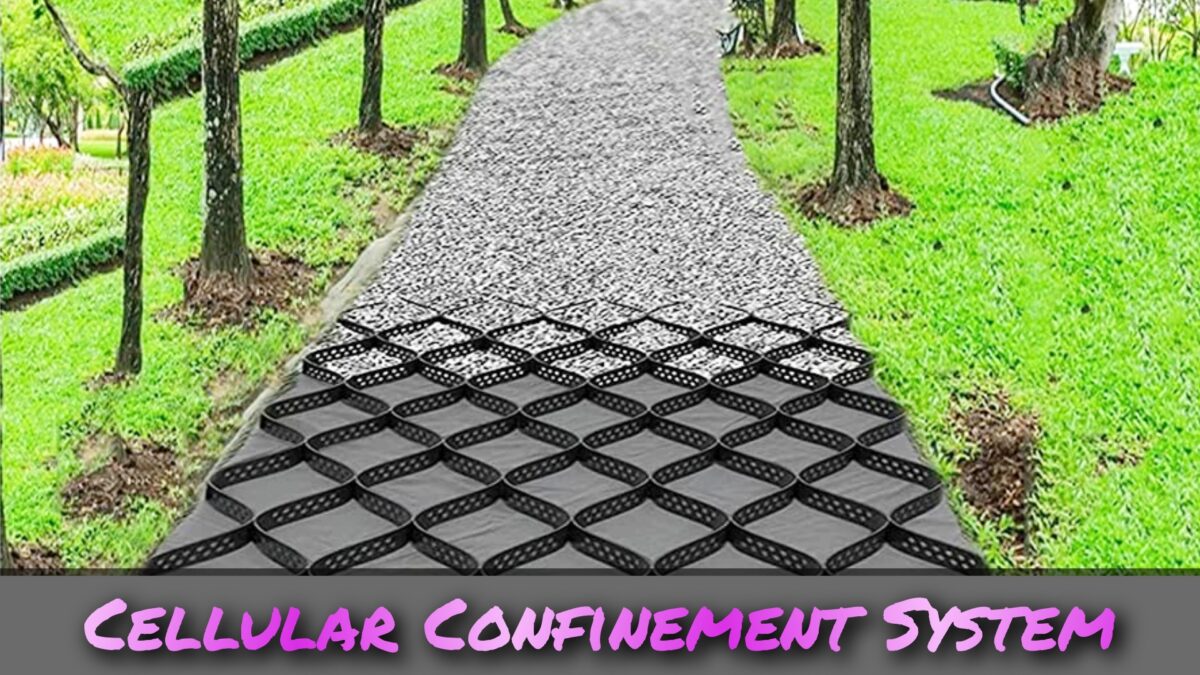Table of Contents
What is Cellular Confinement System?
Cellular confinement systems is a soil stabilization and erosion control technique used in the field of construction. Cellular confinement also known as Geocell. This method is normally used on flat and steep slopes, waterway protection, and structural reinforcement for load bearing and soil retention.

Typical cellular containment systems are geosynthetics made from strips of ultrasonically welded high-density polyethylene (HDPE) or new polymer alloys (NPA), expanded in situ into honeycomb-like structures, and sand-filled with soil, rock, gravel or concrete.
Working Concept
A Cellular Confinement System whilst infilled with compacted soil creates a brand new composite entity that possesses stronger mechanical and geotechnical properties. When the soil contained inside a CCS is subjected to pressure, as withinside the case of a load assist application, it reasons lateral stresses on perimeter mobileular walls. The 3-D quarter of confinement reduces the lateral motion of soil debris even as vertical loading at the contained infill outcomes in excessive lateral strain and resistance at the mobileular-soil interface. These growth the shear electricity of the limited soil, which:
Creates a stiff bed or slab to distribute the weight over a much broader vicinity reduces punching of smooth soil increases shear resistance and bearing ability.
Confinement from adjoining cells presents extra resistance in opposition to the loaded mobileular-soil via passive resistance, even as lateral growth of the infill is confined with the aid of using excessive hoop electricity. Compaction is maintained with the aid of using the confinement, ensuing in long-time period reinforcement.
On site, the geocell sections are fixed collectively and located without delay at the subsoil’s floor or on a geotextile clear out out located at the subgrade floor and propped open in an accordion-like style with an outside stretcher assembly. The sections amplify to a place of numerous tens of meters and include masses of character cells, relying at the segment and mobileular size. They are then filled with various fillers including soil, sand, mix or recycled substances, which are then compacted with a vibrating compactor. The surface layers are usually made up of unbound asphalt or gravel.
Uses of Cellular Confinement System
1. Roadway load support
Cellular Confinement Systems (CCS) have been used to improve the performance of both paved and unpaved roads by reinforcing the soil in the subgrade-base interface or within the base course. The effective load distribution of CCS creates a strong, stiff cellular mattress. This 3D mattress reduces vertical differential settlement into soft subgrades, improves shear strength, and enhances load-bearing capacity, while reducing the amount of aggregate material required to extend the service life of roads. As a composite system, cellular confinement strengthens the aggregate infill, thereby simultaneously enabling the use of poorly graded inferior material for infill as well as reducing the structural support layer thickness. Typical load support applications include reinforcement of base and subbase layers in flexible pavements, including
asphalt pavements, unpaved access, service and haul roads, military roads, railway substructure and ballast confinement, working platforms in intermodal ports airport, runways and aprons.
2. Steep soil slope and channel protection
The three-dimensional lateral confinement of CCS along with anchoring techniques ensures the long-term stability of slopes using vegetated topsoil, aggregate or concrete surfacing (if exposed to severe mechanical and hydraulic pressures). The enhanced drainage, friction forces, and cell–soil–plant interactions of CCS prevent downhill movement and limit the effects of raindrops, channeling, and hydraulic shear stress. 3D Cell Perforation allows the passage of water, nutrients and soil organisms. This promotes plant growth and root connectivity, further stabilizes slopes and soil masses, and promotes landscape restoration. Typical applications are:
Cut and Fill Draft and Structural Stabilization Road and Rail Embankments; Pipeline Stabilization and Storage Facility Berming. quarry and mine restoration; channels and coastal structures; They can be designed as substructures or claddings.
3. Earth Retention
CCS provides mechanically stable steep vertical earth structures (gravity or reinforced walls) for steep walls, walls and irregular terrain. Because each layer is structurally sound, construction of CCS soil retention is simplified, eliminating the need for concrete formwork and curing while allowing access for equipment and workers. If suitable and granular, local soil can be used for filling, but the outer surface allows for horizontal terraces/rows of green or tan fascia using topsoil.Walls can also be used for canal lining can be used. For high flow rates, the outer cells should be filled with concrete or cement slurry. CCS has been used to reinforce soft or uneven ground foundations for large foundations, retaining walls for strip foundations, load balancing covers on pipelines, and other geotechnical applications.
4. Reservoirs and Landfills
CCS provides geo membrane protection while creating stable bottoms, banks and embankments for non-slip protection and permanent retention of liquids and waste. The treatment of the fill depends on the material involved.
concrete for ponds and reservoirs. Gravel for landfill wastewater and leachate, green landfill for landscape restoration. CCS works as pre-built forms, so concrete work is efficient and controlled. Concrete-based CCS forms a flexible slab that accommodates slight subsurface movements and prevents cracking. on average
